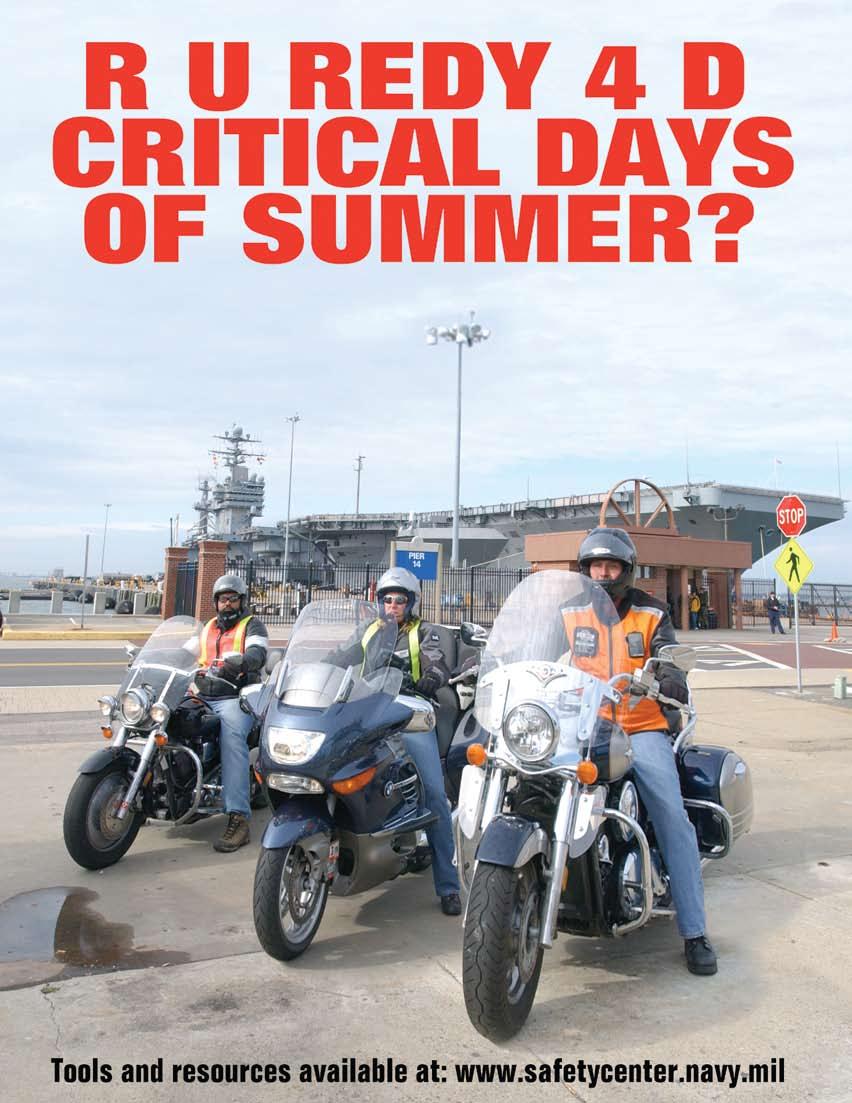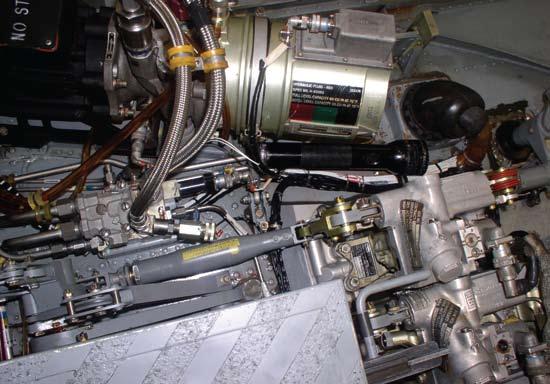
22 minute read
Rushed Tool Check
from Spring 2008
By Lt. Dave Bigay
Tool-control procedures have proven effective and are in place for a reason. However, the program’s effectiveness is contingent on whether the procedures are followed to the letter, every time, and without fail. Follow them, and pilots need not worry. Neglect the procedures, even for a moment, and the results have the potential to be disastrous.
Advertisement
While performing a daily inspection on the flight line at night, on one of the squadron’s SH-60B aircraft, a plane captain found a discrepancy that required repair before an aircraft could launch on its functional check flight (FCF) the next morning. After checking out tools from the tool room, the detachment’s lead AD and two junior ADs did the The flashlight was found in the hydraulics bay of an H-60. required maintenance. When sufficient flashlights were not available in the on-hand toolboxes, an additional flashlight was the det thought all the tools had been accounted for, brought from a toolbox in the hangar. When the team it later was discovered that a flashlight from another finished the job, they hastily packed up their tools, did a toolbox somehow had made its way into the missing tool inventory on the toolboxes at the aircraft, and went flashlight’s toolbox. A simple error had led to nearly their separate ways. disastrous results.
The following morning, more detachment personIf you ask most maintainers, post-maintenance nel did a tool inventory before breaking for lunch and FCFs are like a trip to the dentist: The sooner it’s over, discovered that a flashlight was missing from one of the the better. While the motivation behind this attitude is toolboxes. After they unsuccessfully searched for the purely a desire to get the aircraft back to work supportmissing flashlight, QA was notified of the missing tool, ing the mission as soon as possible, it’s easy to see where and all aircraft were recalled. this attitude can be a recipe for disaster.
The flashlight was found in the hydraulics bay of the This is a good reminder for supervisors that mainteFCF aircraft that had been repaired the previous night. nance never should be rushed. Whether it’s in the qualThe hydraulics bay on the H-60 is located directly over ity of the maintenance being done, tool control, or the the cockpit and cabin of the helicopter and provides the paperwork to back it all up, the chance something was transfer of all of the pilot’s control inputs to the rotor missed increases exponentially when we rush a job, or in hub. This compartment contains dozens of servos, rods this case, during post-maintenance cleanup. and linkages, where a tool could jam, render the flight controls useless, and result in an aircraft crash. Although Lt. Bigay is a pilot with HSL-46.
Send BZs to: SAFE-Mech@navy.
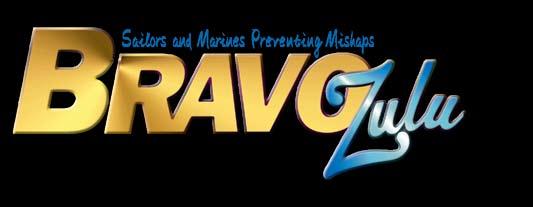
BZ Quarter of the
AMAA Ryan Marshall HS-7

While doing a turnaround inspec- tion on aircraft 617, airman apprentice Marshall determined one of the tailrotor blades felt loose, compared to the others. He did a “teeter test,” which checks for spar integrity and a delami- nating tail rotor. He then found a few cracks near the blade cuff and notified QA. After removing the outboard reten- tion plate, a QAR found the composite fiber layers of the blade spar had started to separate from each other, causing the tail rotor spar to crack along the retention plate. Had the delamination and cracks gone unnoticed, the tail-rotor blade likely would have failed during the next flight.
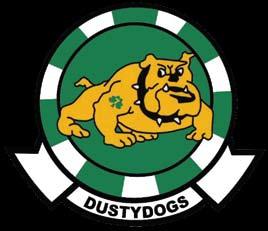
Cpl. Sophia Reiser HMM-365
On a safe-for-flight inspection on a CH-46E, Cpl. Reiser noticed the lord mounts on the synchronization shaft were pushed too far forward. A closer look revealed the inner race for one of the synchronizing drive-shaft bearings was missing. She immediately notified a CDI and QA, who verified the inner race was missing.
An analyst at the Naval Safety Center said the missing inner race might have caused catastrophic failure of the synchronization shaft in flight, resulting in the loss of the aircraft and the lives of the crew.
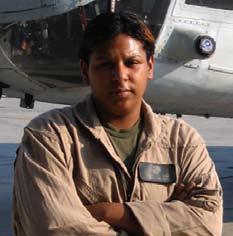
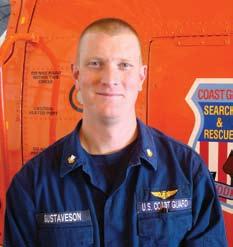
AMT2 Michael Gustaveson
CGAS Kodiak, Alaska
During a recent search-and-rescue (SAR) case to Adak, Alaska, Petty Officer Gustaveson was doing a thruflight inspection on a U.S. Coast Guard MH-60J helicopter CGNR 6035. He suddenly noticed the yellow main-rotor-blade damper was installed incorrectly.
Petty Officer Gustaveson’s attention to detail prevented a premature failure of a dynamic component and prevented a potential aircraft mishap.

AM2 Dustin Maxey HSL-42
Following a night of flying aboard USS Vicksburg (CG-69), Petty Officer Maxey found a cracked piston on the YAW boost-servo assembly of Proud Warrior 431. After discovering the problem on an early morning daily-andturnaround inspection, he immediately notified his supervisor and maintenance control.
Petty Officer Maxey’s keen attention to detail, quick action, and thorough knowledge of plane-captain procedures prevented a potentially catastrophic chain of events.
AM2 Mark Thomas HSL-44
During a routine inspection of Magnum 446, Petty Officer Thomas noticed the sealant deteriorating on the No. 1 input module’s mounting face to the main transmission. A closer look revealed that the input module was corroded severely at critical mounting points.
Had Petty Officer Thomas not found this problem, a catastrophic main-transmission failure would have been likely. AE2 Daniel Coffey HSL-42 Det. 1
During a routine weekly aircraft wash aboard USS Klakring (FFG-42), Petty Officer Coffey found a crack in one of the main-rotor blades of his detachment’s only SH-60B. Ultimately, the cracked rotor blade was not safe for flight and could have resulted in catastrophic failure had it gone undetected.
Petty Officer Coffey’s critical eye led to a timely repair, returning their sole aircraft to full mission-capable status. AT2 Tyler Vidas HSL-42
On a routine FOD inspection on Proud Warrior 431, Petty Officer Vidas found a disconnected wire for the directional-control valve, which is used to position the fire bottles in the SH-60 B’s fire-extinguishing system. Had the aircraft been flown in this condition, the main and reserve fire bottles for all engines would have been inoperable in case of an emergency. His quick actions prevented further problems, and the gripe was fixed.
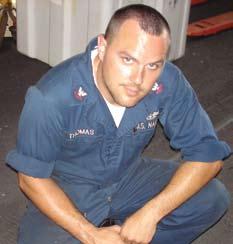
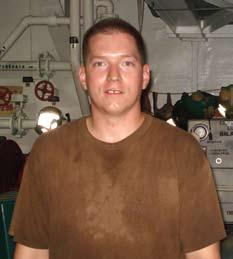
AM3 Trevor Shivdayal HSL-37 Det. 2
Working on an SH-60B aboard USS Chosin (CG 65), Petty Officer Shivdayal located a pinhole leak in a hydraulic-pressure line for the No. 1 tail-rotor servo. Due to the awkward location and size of the hole, the leak would have gone unnoticed until the aircraft returned to flight.
Petty Officer Shivdayal’s keen attention-to-detail and meticulous troubleshooting technique prevented a partial hydraulic-system failure and in-flight emergency.
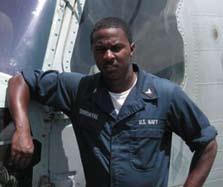
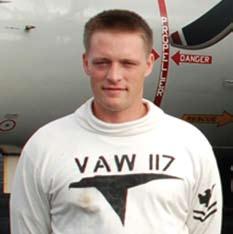
AN Chad Helstrom HSL-51
While doing corrosion work on an SH-60B, Airman Helstrom found the hydraulic unions for the first- and secondstage tail-rotor servos were not seated fully. This vital assembly in the SH-60B controls the aircraft’s heading through the tail rotor. Further inspection revealed that the jam nuts on the backside of the pylon had backed off. His good troubleshooting effort during a mundane task prevented a serious risk to flight safety.
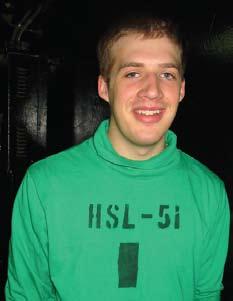

AO2 Alex Ramosruano HSL-37
During a plane captain preflight inspection of the engine compartment of an SH-60B, Petty Officer Ramosruano noticed a missing torque stripe on the B-nut for the load-demand-spindle (LDS) cable. A closer look at the B-nut showed the LDS cable was not secured correctly to the hydro-mechanical control unit (HMU).
Petty Officer Ramosruano immediately notified maintenance control and wrote a downing discrepancy. His ability to recognize and defuse a potentially dangerous situation prevented an in-flight emergency.
AM2 Phillip Boykin VAW-117
Petty Officer Boykin was doing a high-power turn of aircraft 603 in the aft hummer hole aboard the USS Nimitz (CVN-68). During the start of the port engine, he felt the aircraft shift in an unexpected manner. The aircraft’s wings had begun to spread unexpectedly. He quickly cycled the wing-spread lever from folded to spread and back to folded while taking the condition lever to ground stop. This action stopped the wings and caused them to refold, preventing damage to 603 and the surrounding aircraft and equipment.
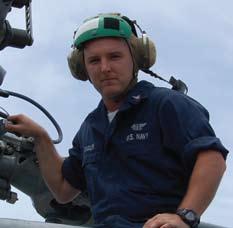
AM2(AW) Philip Sadler HSL-37 Det. 2
During a 7/56-day inspection on an SH-60B aboard USS Reuben James (FFG-57), Petty Officer Sadler prevented a possible mishap when he noticed serious exfoliation corrosion on the hinge bracket of the APU door. Had it gone unnoticed, the hinge likely would have failed, causing the APU door to depart the aircraft. He immediately downed the aircraft and corrected the problem, returning the aircraft to flight status. AD3 Brian Reynolds HSL-51
Petty Officer Reynolds assisted on a 7/28-day special inspection on Walord 701. He found a 4-inch crack on the shear decking below the No. 2 engine intake and immediately reported it to a QA. The crack turned out to be a P&E repair. His keen eye and quick action prevented a possible flight mishap.
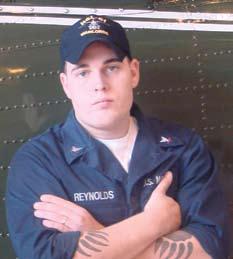
AD2 Chris Davis and
AD3 Marvin Freshwater VFA-102
AD2 Chris Davis and AD3 Marvin Freshwater had been troubleshooting an over-fueling gripe on Diamondback 100 for days. After removing and replacing the wing high- and low-level pilot valves, fuel continued spilling out the vents. Undeterred, they suspected a failure of the high-level pilot valve in the No. 1 tank. When they opened that tank, they found the top of the fuel cell had collapsed. A closer look at the bladder cell showed several rub marks and damage beyond usable limits to the nylon barrier. They ultimately found a problem with the lacing was the culprit behind the collapse, revealing a flaw in the fuel cell and saving hundreds of man-hours in future troubleshooting.

AD1 Joshua Sullivan VPU-2
Petty Officer Sullivan was standing starboard wing observer for a P-3 on the tarmac. After the No. 4 engine was started, AD1 Sullivan noticed the No. 4 propeller’s servicing door was not secured. Recognizing an unsafe situation and using sound principles of ground-resource management, he signaled the lineman to instruct the aircrew to shut down engines. Upon closer inspection, he discovered the door was beyond repair and worked quickly to replace the top after-body. The aircraft then was able to safely execute a successful combat mission.

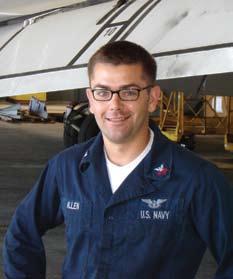
AM1 Matthew Allen VPU-2
While doing a routine daily inspection on a P-3 aircraft, Petty Officer Allen noticed what appeared to be a small crack on the forward skin of the starboard aileron’s trim tab. After a closer look, he found that the attaching hardware for the connecting road to the inboard trim tab was missing, and the remaining hardware in the outboard connecting rod was worn. The missing hardware had caused the rod to rub through the trim-tab skin. The associated linkages were damaged beyond repair.
Petty Officer Allen’s critical safety eye discovered a discrepancy that was not easily seen and could have caused a flight-control failure, leading to the loss of aircraft and crew. AE2(AW) James Beach VR-56
On a look-phase inspection on a C-9B, Petty Officer Beach noticed the port and starboard wingtip-lighting assemblies looked like they had melted. From experience, he knew this problem might be the result of a lightning hit. During the subsequent conditional inspection, he also found a large, burnedout hole on the elevator control tab, confirming a lightning strike.
Petty Officer Beach’s quick action allowed both strobe assemblies and the elevator control tab to be replaced, quickly returning the aircraft to service.
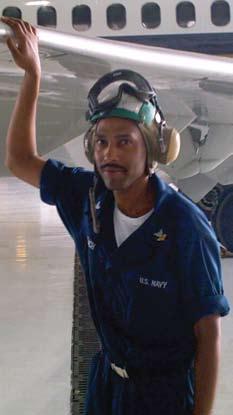
crossfeed
Maintenance Officer
Cdr. Bert Ortiz bert.ortiz@navy.mil
Editorial Coordinator
ADCS(AW) Michael Tate michael.tate@navy.mil
Safety Surveys
Safety Survey Teams Aid Squadrons
By Dan Steber
Adedicated team of maintenance and safety professionals gathered several days before a short trip to North Carolina. The maintainers and “topside” members met to discuss the logistics for the survey trip and commands being looked at. It was the first step in a well-choreographed trip that would affect two squadrons: VMM-162 and VMAQ-2. They would be just two of more than 150 squadrons the safety center team looks at each year.
Shortly after arrival in Havelock, NC, the maintenance team mustered for one final brief before the first survey, which actually took place at MCAS New River in Jacksonville—a 45-minute drive away. The team leader, Capt. Chris Foley and Master Chief Johnnie Simmons briefed the upcoming schedule, the forecasted weather, and team conduct.
The next morning, an early team left the hotel before sunrise. They headed out early to look at the maintenance meeting and FOD walkdown. These are two critical events that start the day off at commands around the fleet. VMM-162 would be no different. “We simply are looking at how they conduct business,” said ADCS Mike Tate. “A lot happens early in the morning.”
The rest of the team arrived about 30-minutes later and mustered in the Gold Eagles Ready Room. It was clear, looking around the room, that this squadron takes safety seriously. CNO Safety “S” plaques ran down one complete wall: 1956, 71, 83, 90, 96, 98, 99, 2000, 01, 02, and 03.
LtCol. Karsten Heckl, VMM-162, briefed his people about the visit and introduced the team’s senior officer, LtCol. Jon McCartney. He addressed the past successes the command faced during group and ADMAT inspections, saying, “We’ve been adamant about doing things the right way. The staff NCOs across the command are good, and they are known across the community.”
LtCol. McCartney introduced the topside folks and told the CO and the command, “We’ll give you a good honest look. And when we walk away…we leave with nothing, the results stay with you.”
That point has been a highlight of the Naval Safety Center surveys. Some of the team calls it the “white hat” approach, meaning no punitive results come from the survey. The team looks for, finds and reports problem areas, but it then is up to the command to take action to fix any discrepancies. The problem areas are not reported to the group, wing or type commander.
After Capt. Foley and Master Chief Simmons introduced and matched up maintenance counterparts, the team and work center supervisors headed to the shops to begin the survey.
In airframes, Cpl. Mike Green of Atlanta, GA., worked with AMC(AW) James Litviak on some corrosion control items. They looked at respirator fit tests and discussed ways to avoid problems, including a recommendation for 100% fit test. They looked at training records, passdown logs, tool control, and many other maintenance programs.
In another maintenance space, ADCS(AW/SW) Chris Smith worked with Sgt. Ed Bukowski of Ripon, WI. They went through the command’s tool room with a fine-tooth comb. When asked about any surprises, the Sgt. said, “Hearing stickers on the etchers. I thought the sound was well under decibels. It showed why we must keep up with programs. We never can take our jobs lightly.”
The level of detail that the team looks at surprises people. Sgt. Wesley Sweeny of Atlanta, GA was working with AEC(AW) James Esslinger and
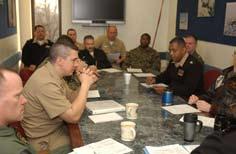
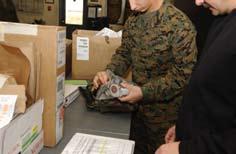
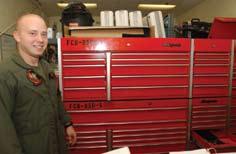
repeated a often-heard comment during the twoday trip: “I thought the team just was going to look at safety items like electrical plugs, extinguishers, hazmat, and similar items.” The Sgt. did say that the team, “Gave us ideas seen in other squadrons they’ve looked at around the world and will make it [programs] easier and better.” He went on to describe that the survey “definitely was different” than inspections he’d been through.
When asked what was different, he explained the team’s process of asking a question, showing what they had, and then moving into “the training mode.” He added, “It was one of the best looks I’ve had. The chief never made it feel like a reprimand. We discussed things. He broke out the reference, and we talked about what the book says and how we do things. The chief gave me things to look at and people to call should I get stuck.”
GySgt. Jason Kanakis, a 20-year Marine, plankowner, QA chief from Detroit, Mi., said, “You end up learning something new.”
Cpl. Carlos Santiago of Wilmington, Del., an admin clerk, said “I picked up some info that’s in the manual, stuff that’s in black and white. We had
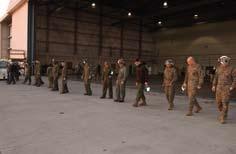
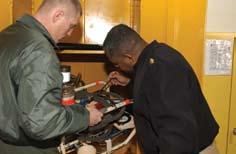

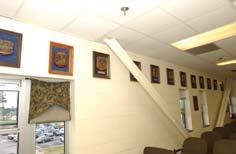
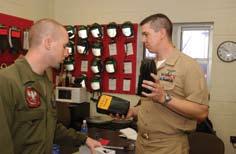

a nice ‘give and take’ training session. This survey helped polish my experience, gave me a broader outlook on my role in the squadron. We covered areas so I could learn and make sure safety procedures are being followed.”
SSgt. Yancy Genoa, paraloft shop supervisor, said, “I enjoyed the visit. It was more ‘calming’ than other inspections. The way PRC Brian Westcott went through the programs and showed us how to do things more effectively and efficiently was great.”
The team ended day one with a debrief, and all supervisors were invited back to the ready room. The maintenance team members already had briefed their counterparts in the work centers, but this gathering was a chance for them to hear an overall, generalized ranking and comparison with other squadrons. That session also went over positive things found throughout the command. The Golden Eagles were slightly better than average.
The next day, the team visited VMAQ-2, and the day went very much the same.
The skipper, LtCol. Robert Sherrill, had a prebrief in his office with the Naval Safety Center’s topside team and Capt. Foley. “We appreciate you
coming down to look at us,” Sherrill said. “I think you’ll find a good group of professionals.”
LtCol. McCartney echoed his earlier statement about leaving with nothing, but he added, “…but trends and best practices that your command may want to share with us.”
That one sentence summed up an important value of the survey process. A squadron gets a “free” look, but the Navy and Marine Corps win because of the sharing of ideas, programs and effective efforts than may work at other commands in the fleet.
LtCol. McCartney has a favorite saying, “Open the kimonos, show us what you’ve got, and let us help you with any issues that you might have.”
No squadron is perfect. Some are a little better than others, but every maintainer and aviator is doing their best to make things safe.
AFCM(AW) Johnnie Simmons told the maintainers at VMAQ-2, “My guys love going around and finding issues, but they then shift to the training mode to help you out.” And once again, the team did just that with their one-day, snapshot look at maintenance. By AMCS(AW) Robert Chenard
Hazardous Material – CNAF 4790.2A, CH 10, Par. 10.19.3.4(Q) states the “HMC&M Supervisor shall maintain a HAZMAT log to identify material issued, used, retained for reuse, and disposed of as HAZWASTE.” Finding unaccounted for HAZMAT in shop spaces is a common problem, so don’t let co-workers put you in a bind. You also want to show that you track and follow-up on daily use materials. A “best practice” I’ve seen is to require a tool tag for HM, and then carry that material over to the next day if it really is required to be held over night.
MSDS and unique identifiers go hand in hand. CNAF 4790.2A, CH 10, Par. 10.19.3.4(C), requires the HMC&M supervisor to “maintain an up-to-date library of MSDS,” and OPNAVINST 5100.23G, para. 0702g(5) is the requirement for the unique identifier.
Sgt. Joe Medrano of San Antonio, Texas, said, “Chief Westcott was a good inspector and did things differently. He actually sat here and went through the programs. We discussed things and I got a lot of good training from him.”
Those comments were consistent and similar with everyone.
GySgt. Scott King, QA Chief, said the survey was more than he had expected. “I like the idea of someone coming in, taking a look, and telling us how we’re doing. And then we quickly can get back to business. It’s not a long, drawn-out process. I also like the fact the team followed a specific checklist. The program-tracking database Senior Chief Tate recommended was a great idea. It will help me follow-up on all programs and audit discrepancies.”
LtCol. Sherrill summed it all up with one simple statement, “Your look gives us a good rudder steer on where we have to go.”
For more information on the survey teams and to get their published schedule, visit the Naval Safety Center website at www.safetycenter.navy.mil/ aviation/checklists/default.htm and www.safetycen
Airframes
Fixing Airframe-Related Problems — Part II
ter.navy.mil/aviation/surveys.htm.
A “Right to Know Station” is where MSDS binders should be kept. The best place for this is where it can be reached in an emergency. It should not be locked up, or kept in a work center that is not open when personnel are working.
A unique identifier is a numbering system to quickly identify the material in case of an emergency. The identifier should be kept as simple as possible and be located on the chemical label, MSDS, AUL, and inventory sheets. You can use letters, numbers, the MSDS number, or any combination. The key is quick identification and retrieval.
Finally, HAZMAT needs to be in an approved container and have a label. Secondary labeling is required for all containers when HM has been transferred from original containers. A “best practice”
I’ve seen is printing and laminating the small label (DD 2521) and then safety wiring it to the secondary container, for example, a grease gun.
Best Practice: Our grading scale compares your command against what we are seeing in the rest of the Navy and Marine Corps. “Below Average” lets you know more effort is necessary with programs. “Above Average” says you abide with the references, and you are doing more than other commands, but you still have room for improvement. Here is a sampling of recent visits where commands have had good programs:
VFA-87: Six above average programs, none below average.
FRC NW: Five above average programs, none below average.
VMR-1: Two above average programs, none below average.
HSC-22, HSC-25, HSL-37, MALS-31, VAQ-133, By ADCS(AW) Michael S. Tate
From December 18, 2007 to March 13, 2008, the Navy and Marine Corps had 12 Class C Mishaps involving 12 aircraft.
Once again this quarter, we had a lot more TFOAs. We must get better at this area because it costs us time and money, and it has the potential to injure people on the ground. QA needs to do trend analysis to prevent the recurrence of TFOAs.
We had a few other incidents, including a Sailor who suffered a severe thumb injury while working on landing gear, and there were more aircraft crunches. These events are very similar to last quarter.
One new item was equipment shorting out during maintenance. We need to look a little closer at this problem.
The most common cause of shorted equipment is multiple maintenance actions being done simultaneously on aircraft. No one is saying you can’t do multiple actions. In fact, it is necessary to keep our aircraft on the flight schedule. However, we often lack awareness of other maintenance actions being performed on the aircraft. It’s very easy to go from one maintenance action to another, but unfortunately, that approach creates tunnel VMFA-312, and VMM-263: One above average program, none below average.
Your command can be on this list with just a few simple steps.
Senior Chief Chenard is a maintenance analyst at the Naval Safety Center.
Survey Schedule
May 2008
June 2008
August 2008
September 2008
Cherry Point New River
PAX River Brunswick Maine
NAS Whidbey Island
Camp Pendleton
Class C Mishap Summary
North Island vision. For example, we troubleshoot a maintenance action on one aircraft and order parts, and then troubleshoot another aircraft, while waiting for the parts. The down side occurs when we get the parts a few hours later, run back out to the aircraft, and fail to repeat the set-up checks. We forget to make sure the breakers are set where we left them, verify power isn’t applied, or check with maintenance control to see if other maintenance has been or is being done on the aircraft. Our haste to get the job done often can lead to more work, damaged parts, and an injury.
Never is maintenance pressure so high that we can’t get the job done using the book. That pressure is real, and we know your supervisor and maintenance want the gripe fixed now, along with the other 10 items you need to complete today. Only you can decide how you react to these pressures. But remember, pressure is not an excuse to take shortcuts. Take the prep time to do the job right. It’s time well spent and ultimately will allow us to have more aircraft ready for the flight schedule.
Senior Chief Tate is a maintenance analyst at the Naval Safety Center and coordinator of the Crossfeed section of Mech.
H otel Sierra Helping Sailors and Marines Help Themselves Sierra H otel
Commander, Naval Safety Center would like to recognize the following aviation commands for their recent participation in safety surveys, culture workshops, and maintenance malpractice resource management (MRM) presentations for the months of December-March.
Safety Surveys
VT-21 VT-22 HM-15 VT-28 VT-27 VT-31 VT-35 VMFT-401 VMA-311 VMA-211 HS-10 VMFA-242 VRC-30 HSL-49 VMM-162 VMAQ-1 HSC-84 HM-14 VFA-195 VFA-27 VFA-102 VAQ-136 HT-8 HT-18 HT-28 VT-2 VFA-102 HS-14 VT-3 VT-6 VAW-115 VT-4 VT-10
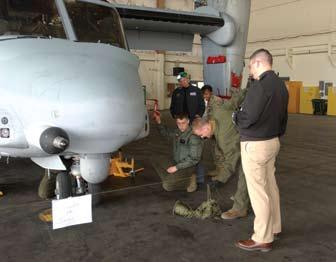

VT-86 VAW-113 VAW-116 VAW-112 VR-55 HMMT-164 HMLA/T-303 HMLA-267 VR-56 VAW-123
MRMs
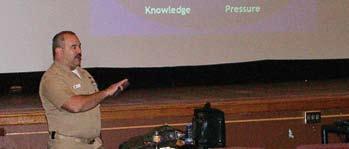
VFA-34 VX-23 AMO School HCS-26 FRC MID Atlantic VAW-124 AIMD Atsugi CVW-5 Squadrons RESTACSUPWING
Culture Workshops
VMAQ-3 VMMT-204 HM-14 HS-11 HS-15 HSC-22 HSC-28 HSL-42 HSL-48 VAW-123 VAW-125 VP-16 VP-5 VQ-3 VQ-4 HSL-47 HSM-71 VAQ-129 VAQ-137 VAQ-138 VAQ-141 VAW-112 VFA-115 VFA-122 VFA-14 VFA-22 VR-48 VR-58 VT-6
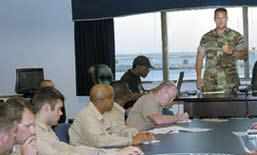
For more information or to get on the schedule, please contact: Safety Surveys: Capt. Chris Foley, USMC at 757-444-3520 Ext. 7223, MRM: AEC Matthew Cooper at 757-444-3520 Ext. 7275, Culture Workshop: Cdr. John Morrison at 757-444-3520 Ext. 7213.
